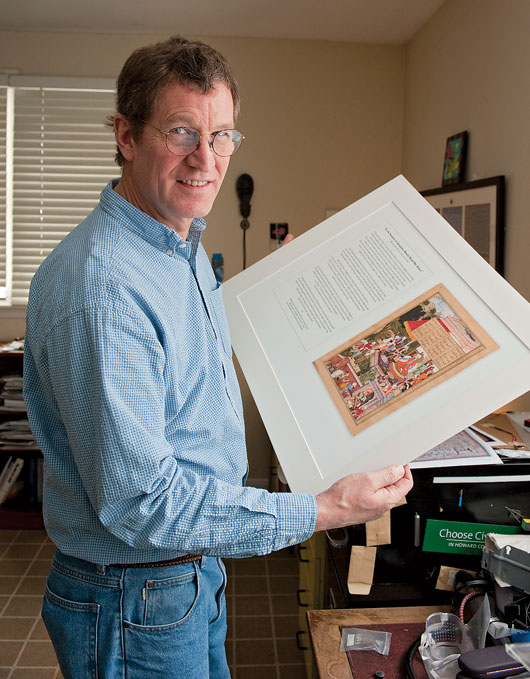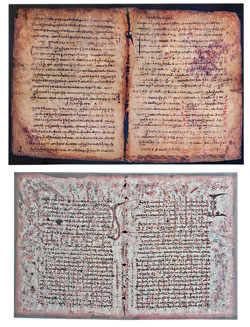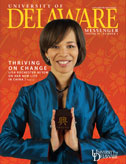History's mysteries

ALUMNI | He was there to analyze the Gettysburg Address just before the 200th anniversary of Abraham Lincoln’s birthday. Instead, William Christens-Barry, AS ’79, found himself working on something he hadn’t expected that January 2009 day at the Library of Congress: the president’s pocket contents from the time of his assassination.
“They were very personal objects—his wallet, his train schedule, his comb, a few little handwritten notes,” Christens-Barry says. “That felt a little eerie because here we are with the real objects and this is a very emotional thing.”
A close look at the president’s handkerchief for traces of blood that day didn’t yield groundbreaking finds, but numerous other efforts by the UD physics grad have. His pioneering application of an imaging technique originally used in the biomedical field is leading to new discoveries, revealing unidentified fingerprints on the Gettysburg Address and helping decode text on a 3,000-year-old shard of pottery from near the site of the biblical encounter between David and Goliath.

A breakthrough by Christens-Barry that turned heads last summer was the finding that Thomas Jefferson had expunged the word “subjects” and written “citizens” in its place in an early draft of the Declaration of Independence. Experts had long theorized about the draft’s lone erasure, and the answer showed that Jefferson hadn’t liked the initial nod that “subjects” gave to England’s rule.
“It’s almost like we can see him write ‘subjects’ and then quickly decide that’s not what he wanted at all, that he didn’t even want a record of it,” Library of Congress preservation director Dianne van der Reyden told The Washington Post about the discovery. “Seldom can we re-create a moment in history in such a dramatic and living way.”
Re-creating historical moments was not on Christens-Barry’s mind as he earned a doctoral degree in physics from the University of Alabama-Birmingham, nor as he worked at Johns Hopkins’ Applied Physics Lab from 1988–2000. As a research physicist with a joint appointment at the School of Medicine, he used a variety of imaging techniques to study the molecular structure of the cornea, DNA of breast and prostate cancer and even planetary surfaces such as moon dirt.
Then one day in 1999, he took a trip to the Walters Art Museum in Baltimore, where a moldy, tattered, 1,200-year-old manuscript was on display. Seeing it got him thinking about an imaging method he employed at Johns Hopkins. Using extremely high-resolution cameras and different wavelengths of light, he would identify a characteristic spectrum for each type of content on a surface. He would then merge the many images with the help of computers to reveal information not seen by the naked eye.
“Seeing the book, I realized, ‘Oh, this is just old skin from my research.’ I could apply some of the techniques I use in medical and biological imaging,” he says, praising his physics background for giving him the ability to analyze problems independent of their context.
In fact, that day at the art museum, he was looking at old skin. The manuscript was on parchment, the primary writing material used at the time. The book’s more visible writing was done by 13th century scribes, who were likely looking to save a few sheep when they scraped off an older text to record a prayer book.
The underlying original text—and that which made the book’s discovery one of the most important 20th century finds in the world of antiquarian and historic manuscripts—was authored by Archimedes, the third-century mathematician and physicist recognized as an early developer of calculus principles. Archimedes’ text was there, but it was beneath many years of use and wear. Christens-Barry became part of a team of interdisciplinary experts who worked over eight years and evolved the use of his imaging technique to find out what it said.
Among the hidden layers, they found the only surviving copies of three of Archimedes’ treatises, an invaluable resource for experts trying to understand the scholar’s intellectual orientation and thought process. Also revealed was a text by ancient Greek speechwriter Hypereides and the first-ever mention of Alexander the Great.
Sorting it all out wasn’t easy.
“In a mathematics text, every symbol is important,” Christens-Barry says. “The meaning and understanding and importance of whole pages can hinge on just one or two characters. Does it say equal to, or greater than, or not equal to?”
Yet there are other benefits to Christens-Barry and his colleagues embarking on such projects. The digital images they capture can be posted online, allowing precious, fragile artifacts to remain tucked safely away while researchers around the globe study them. The highly detailed, 600 dpi images allow the team to characterize the integrity of any item they capture so that experts can address changes over time, including degradation such as fading or the growth of fungus or mold.
There’s also their ability to create highly accurate reproductions of these historical treasures. Working with Santa Barbara-based company Megavision and its chief executive Ken Boydston in 2008, Christens-Barry and a team of imaging scientists created a reproduction of the Waldseemuller Map, the map that gave the Americas their name. Other replicas they have collaborated on include paintings by Manet, Matisse’s “Pot of Geraniums” and working sketches for the Sistine Chapel by Michelangelo.
It’s an improbable list of projects already, but still there’s more. Demand for the new application of the imaging technique has spurred travels to Europe and Egypt. And his next project could be his grandest thus far: He is part of a team tasked with imaging the Dead Sea Scrolls. The effort, which also involves Google’s Israel research and development group, is intended to provide digitized versions of the highly prized manuscripts online and to produce imaging data that will be central to research carried out for years to come.
For Christens-Barry (who met his wife, Carol Christens-Barry, AS ’78, at UD), working with such valuable, historic items doesn’t make him breathless as it did initially.
“You have to devise elaborate procedures; you think, ‘If I have to put cameras over something, what could go wrong? If I have a lens cap it’s got to be tethered,’” he says, explaining that applying physics to the humanities truly captivates him. “It’s just awesome. I love the diversity of people and their very different mindsets that make success possible in these projects.”
Article by Elizabeth Boyle





